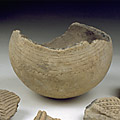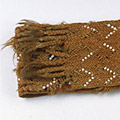
European explorers and settlers of the sixteenth and seventeenth centuries did not discover a "New World." These newcomers encountered an indigenous people who existed in intricate spiritual relationships with the land and all other living beings in their environment. Our understanding of these earliest inhabitants is limited. Euro-American observations of Native people and their lifeways frequently ignore oral history and cultural traditions in favor of written documents and surviving artifacts. While many artifacts have decayed over time, surviving examples of bone, pottery, and a few fragments of wooden objects reveal the intricacy of Native craftwork and tools.
The consequences of contact between Europeans and the inhabitants of what would come to be called "the Americas" were profound on both sides. New trading partners and novel trade goods generated new relationships and destabilized old ones. European traders and settlers triggered devastating epidemics when they unwittingly introduced measles, smallpox, typhus and other Old World diseases to the New World. By the 1630s, the "Great Migration" of English people to New England began. These immigrants came with assumptions and beliefs that condemned the original inhabitants as ignorant, irreligious, roving savages who lacked valid claims to the land or its resources. Resulting conflicts over land and resources yielded tragic results in an ever-shifting world of political alliances and warfare.
Abenaki (Wabenaki) man and woman, 17th century
Image Credit: City of Montreal. Records Management and Archives.
|








